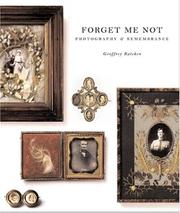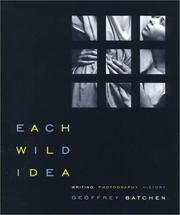| Listing 1 - 10 of 34 | << page >> |
Sort by
|

ISBN: 1568984502 Year: 2004 Publisher: New York (N.Y.) Princeton Architectural Press
Abstract | Keywords | Export | Availability | Bookmark
 Loading...
Loading...Choose an application
- Reference Manager
- EndNote
- RefWorks (Direct export to RefWorks)

ISBN: 0262024276 9780262024273 9780262522595 0262522594 Year: 1997 Publisher: Cambridge, Mass.: MIT Press,
Abstract | Keywords | Export | Availability | Bookmark
 Loading...
Loading...Choose an application
- Reference Manager
- EndNote
- RefWorks (Direct export to RefWorks)
In an 1828 letter to his partner Nicephore Niepce, Louis Daguerre wrote, "I am burning with desire to see your experiments from nature." In this book, Geoffrey Batchen analyzes the desire to photograph as it emerged within the philosophical and scientific milieus that preceded the actual invention of photography. Recent accounts of photography's identity tend to divide between the postmodern view that all identity is determined by context and a formalist effort to define the fundamental characteristics of photography as a medium. Batchen critiques both approaches by way of a detailed discussion of photography's conception in the late eighteenth and early nineteenth centuries. In this refiguring of the traditional story of photography's origins, Batchen examines the output of the various nominees for "first photographer," then incorporates this information into a mode of historical criticism informed by the work of Michel Foucault and Jacques Derrida. The result is a way of thinking about photography that persuasively accords with the medium's undeniable conceptual, political, and historical complexity.
Critique photographique. --- Fotografie. --- Fotografía --- Ontstaansgeschiedenis. --- Photographic criticism. --- Photographie --- Photography --- Histoire. --- History. --- Criticism, photographic --- Critique photographique --- Fotografische kritiek --- Photography -- criticism --- Geoffrey Batchen --- Niépce Nicéphore --- Daguerre Louis --- fotografische theorie --- fotografie en kunst --- fotografie en schilderkunst --- Photographic criticism --- CDL --- 77.01 --- History --- Photography criticism --- Criticism --- 77 "18" --- fotografie --- negentiende eeuw --- camera obscura --- daguerreotypie --- 77.035 --- 77 "18" Fotografie--19e eeuw. Periode 1800-1899 --- Fotografie--19e eeuw. Periode 1800-1899 --- 77.01 Fotografie--Semiotiek van de fotografie. Theorie --- Fotografie--Semiotiek van de fotografie. Theorie --- Photography - History

ISBN: 0262267896 1423729560 9780262267892 0262523248 9780262523240 0262024861 9780262024860 Year: 2000 Publisher: Cambridge, Mass. MIT Press
Abstract | Keywords | Export | Availability | Bookmark
 Loading...
Loading...Choose an application
- Reference Manager
- EndNote
- RefWorks (Direct export to RefWorks)
In Each Wild Idea, Geoffrey Batchen explores a wide range of photographic subjects, from the timing of the medium's invention to the various implications of cyberculture. Along the way, he reflects on contemporary art photography, the role of the vernacular in photography's history, and the Australianness of Australian photography. The essays all focus on a consideration of specific photographs--from a humble combination of baby photos and bronzed booties to a masterwork by Alfred Stieglitz. Although Batchen views each photograph within the context of broader social and political forces, he also engages its own distinctive formal attributes. In short, he sees photography as something that is simultaneously material and cultural. In an effort to evoke the lived experience of history, he frequently relies on sheer description as the mode of analysis, insisting that we look right at--rather than beyond--the photograph being discussed. A constant theme throughout the book is the question of photography's past, present, and future identity.
Photography. --- Photography --- Philosophy. --- ARTS/Photography & Film/General --- 77.01 --- 77 <94> --- 77 <94> Fotografie--Australië --- Fotografie--Australië --- 77.01 Fotografie--Semiotiek van de fotografie. Theorie --- Fotografie--Semiotiek van de fotografie. Theorie --- Philosophy --- History --- Photography - History --- Photography - Philosophy
Book
ISBN: 9780714841984 0714841986 Year: 2008 Publisher: London : Phaidon Press,
Abstract | Keywords | Export | Availability | Bookmark
 Loading...
Loading...Choose an application
- Reference Manager
- EndNote
- RefWorks (Direct export to RefWorks)
fotografie --- Talbot, William Henry Fox --- Photography, Artistic --- Photography --- 77.071 TALBOT --- Groot-Brittannië --- negentiende eeuw --- Talbot William Henry Fox --- Artistic photography --- Photography, Pictorial --- Pictorial photography --- Art --- History --- Aesthetics --- Talbot, William Henry Fox, --- Talbot, Fox, --- Talbot, H. Fox --- Talbot, Henry Fox, --- Fox Talbot, William Henry, --- Talbot, Vilʹi︠a︡m Genri Foks, --- Talbot, William Henry Fox.
Book
ISBN: 9783865022172 Year: 2009 Publisher: Leipzig Seemann
Abstract | Keywords | Export | Availability | Bookmark
 Loading...
Loading...Choose an application
- Reference Manager
- EndNote
- RefWorks (Direct export to RefWorks)
Book
Abstract | Keywords | Export | Availability | Bookmark
 Loading...
Loading...Choose an application
- Reference Manager
- EndNote
- RefWorks (Direct export to RefWorks)
Book
ISBN: 9780909952808 9788073314958 Year: 2018 Publisher: Sydney Power/NAMU
Abstract | Keywords | Export | Availability | Bookmark
 Loading...
Loading...Choose an application
- Reference Manager
- EndNote
- RefWorks (Direct export to RefWorks)
An engaging and provocative account of photography's first commercial applications in England and their global implications. This book addresses a persistent gap in the study of photography's history, moving beyond an appreciation of single breakthrough works to consider the photographic image's newfound reproducibility and capacity for circulation through newsprint and other media in the nineteenth century.
Photography --- photography [process] --- commercial photography --- reproductions [derivative objects] --- anno 1800-1899 --- England
Book
ISBN: 1000224708 0429356811 1000224767 Year: 2021 Publisher: London ; New York, New York : Routledge,
Abstract | Keywords | Export | Availability | Bookmark
 Loading...
Loading...Choose an application
- Reference Manager
- EndNote
- RefWorks (Direct export to RefWorks)
"As its title suggests, Negative/Positive begins with the negative, a foundational element of analog photography that is nonetheless usually ignored, and uses this to tell a representative, rather than comprehensive, history of the medium. The fact that a photograph is split between negative and positive manifestations means that its identity is always simultaneously divided and multiplied. The interaction of these two components was often spread out over time and space and could involve more than one person, giving photography the capacity to produce multiple copies of a given image and for that image to have many different looks, sizes and makers. This book traces these complications for canonical images by such figures as William Henry Fox Talbot, Kusakabe Kimbei, Dorothea Lange, Man Ray, Seydou Keïta, Richard Avedon, and Andreas Gursky. But it also considers a number of related issues crucial to any understanding of photography, from the business practices of professional photographers to the repetition of pose and setting that is so central to certain familiar photographic genres. Ranging from the daguerreotype to the digital image, the end result is a kind of little history of photography, partial and episodic, but no less significant a rendition of the photographic experience for being so. This book represents a summation of Batchen's work to date, making it be essential reading for students and scholars of photography and for all those interested in the history of the medium"--
Photography --- History.
Book
ISBN: 9780367405830 9780367405847 0367405849 0367405830 Year: 2021 Publisher: Abingdon, Oxon Routledge
Abstract | Keywords | Export | Availability | Bookmark
 Loading...
Loading...Choose an application
- Reference Manager
- EndNote
- RefWorks (Direct export to RefWorks)
"As its title suggests, Negative/Positive begins with the negative, a foundational element of analog photography that is nonetheless usually ignored, and uses this to tell a representative, rather than comprehensive, history of the medium. The fact that a photograph is split between negative and positive manifestations means that its identity is always simultaneously divided and multiplied. The interaction of these two components was often spread out over time and space and could involve more than one person, giving photography the capacity to produce multiple copies of a given image and for that image to have many different looks, sizes and makers. This book traces these complications for canonical images by such figures as William Henry Fox Talbot, Kusakabe Kimbei, Dorothea Lange, Man Ray, Seydou Keïta, Richard Avedon, and Andreas Gursky. But it also considers a number of related issues crucial to any understanding of photography, from the business practices of professional photographers to the repetition of pose and setting that is so central to certain familiar photographic genres. Ranging from the daguerreotype to the digital image, the end result is a kind of little history of photography, partial and episodic, but no less significant a rendition of the photographic experience for being so. This book represents a summation of Batchen's work to date, making it be essential reading for students and scholars of photography and for all those interested in the history of the medium"--
Photography --- History

ISBN: 156898619X Year: 2004 Publisher: New York (N.Y.) Princeton architectural press
Abstract | Keywords | Export | Availability | Bookmark
 Loading...
Loading...Choose an application
- Reference Manager
- EndNote
- RefWorks (Direct export to RefWorks)
| Listing 1 - 10 of 34 | << page >> |
Sort by
|

 Search
Search Feedback
Feedback About UniCat
About UniCat  Help
Help News
News